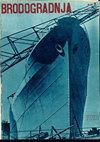Estimating bulk carriers’ main engine power and emissions
IF 4.2
4区 工程技术
Q1 ENGINEERING, MARINE
引用次数: 3
Abstract
Great importance is had in understanding the current situation of maritime transport and making predictions about its future. Maritime transport is an essential part of transportation, and correctly predicting installed main engine power has great significance in maritime transport with regard to fuel consumption and the generation of emissions. Nonlinear regression is a method with great potential in making predictions, as it allows for more realistic models to be developed using multiple variables. Vessels' dimensions of carrying capacity, gross tonnage, length, and breadth significantly impact the required main engine power. This article will calculate and estimate the installed main engine power for bulk carriers through nonlinear regression using data for the as yet highest number of bulk carriers (n = 9,174 ships) and compare the results with the studies in the literature. The developed model has an accuracy of 93.2% for six different bulk carrier types (Small, Handysize, Handymax, Panamax, Capesize, and Large Capesize). In addition, the study calculates the emissions these ships produce (NOx, SO2, CO2, HC, PM), estimating and demonstrating a nonlinear linear regression model for these ships' emission amounts. The performed analyses have found the main engine power required per unit of load to decrease as ship size increases. However, these analyses also show the emissions generated per unit of load to decrease as size increases, with Large Capesize vessels being found to have the lowest fuel consumption and emission generation per unit of load.估计散货船的主机功率和排放
了解海上运输的现状并对其未来作出预测是非常重要的。海上运输是交通运输的重要组成部分,正确预测装机主机功率对海上运输的燃油消耗和排放产生具有重要意义。非线性回归是一种具有巨大预测潜力的方法,因为它允许使用多个变量开发更现实的模型。船舶的载重量、总吨位、长度、宽度等尺寸对所需的主机功率有较大影响。本文将使用迄今为止最大数量的散货船(n = 9,174艘)的数据,通过非线性回归计算和估计散货船安装的主机功率,并将结果与文献中的研究进行比较。所开发的模型对六种不同类型的散货船(小型,灵动型,灵动型,巴拿马型,好望角型和大型好望角型)的精度为93.2%。此外,该研究还计算了这些船舶产生的排放量(NOx, SO2, CO2, HC, PM),估计并展示了这些船舶排放量的非线性线性回归模型。所进行的分析发现,每单位负载所需的主机功率随着船舶尺寸的增加而减小。然而,这些分析还表明,随着尺寸的增加,每单位负载产生的排放量会减少,大型好望角型船舶的燃料消耗和每单位负载产生的排放量最低。
本文章由计算机程序翻译,如有差异,请以英文原文为准。
求助全文
约1分钟内获得全文
求助全文
来源期刊

Brodogradnja
ENGINEERING, MARINE-
CiteScore
4.30
自引率
38.90%
发文量
33
审稿时长
>12 weeks
期刊介绍:
The journal is devoted to multidisciplinary researches in the fields of theoretical and experimental naval architecture and oceanology as well as to challenging problems in shipbuilding as well shipping, offshore and related shipbuilding industries worldwide. The aim of the journal is to integrate technical interests in shipbuilding, ocean engineering, sea and ocean shipping, inland navigation and intermodal transportation as well as environmental issues, overall safety, objects for wind, marine and hydrokinetic renewable energy production and sustainable transportation development at seas, oceans and inland waterways in relations to shipbuilding and naval architecture. The journal focuses on hydrodynamics, structures, reliability, materials, construction, design, optimization, production engineering, building and organization of building, project management, repair and maintenance planning, information systems in shipyards, quality assurance as well as outfitting, powering, autonomous marine vehicles, power plants and equipment onboard. Brodogradnja publishes original scientific papers, review papers, preliminary communications and important professional papers relevant in engineering and technology.
 求助内容:
求助内容: 应助结果提醒方式:
应助结果提醒方式:


